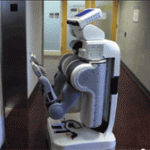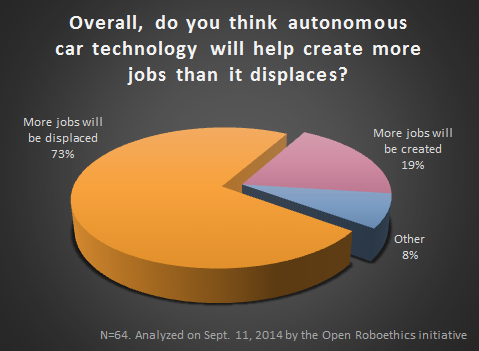Learn about autonomous cars
 Today, we drive our cars. In the future, they’ll do the driving.
Today, we drive our cars. In the future, they’ll do the driving.
Autonomous cars are no longer a far-off futuristic dream, but something that we can expect to see on the road within the next decade.
One of the first autonomous cars appeared in the ‘80s, when a Mercedes Benz team made a van drive on empty streets with speeds of up to 100 km/h. A number of projects followed. Autonomous driving on natural terrain using sensors was achieved in 1987 by HRL Laboratories on an Autonomous Land Vehicle (ALV) funded by DARPA. In 1995, Mercedes Benz team achieved a 95% autonomous driving on a trip of 1600 km in Europe. In 2001, US Government funded projects such as Demo I, II and III, achieved many miles of unmanned driving off the road while avoiding all kinds of natural obstacles. From 2004 through 2007, DARPA Grand Challenge competitions for driverless cars took place, with prizes of 1 and later 2 million dollars, which hosted many different competing teams by major universities and served as a platform for improving the technology even further. Every year, the winning team of the race performed harder and harder tasks. As of today (beginning of 2014), autonomous cars have driven autonomously for hundreds of thousands of miles in total — although the cars are still in experimental and development stages.
[pullquote]Some companies already announced when they expect to release their autonomous cars on the market.[/pullquote] Some companies already announced when they expect to release their autonomous cars on the market. For example, Nissan announced its plans to launch several driverless cars by 2020; Ford unveiled they’ll release a self-driving car in 2025; Google and Tesla motors are even more optimistic, forecasting the first release to take place around 2018. General Motors, Audi and BMW also have autonomous vehicles in development.
Unlike vendors and producers, consumers and regulators still haven’t entirely warmed up to the idea of autonomous vehicles.
Speaking from a legal point of view in June 2011, the Nevada Legislature passed a law to authorize the use of autonomous cars. Nevada thus became the first jurisdiction in the world where autonomous vehicles might be legally operated on public roads. [pullquote]On 25 September 2012, California Governor signed a bill allowing the legalization of driverless cars in the state of California but “the driver would still need to sit behind the wheel in case the robotic functions of the car suddenly fail and a real driver is needed”.[/pullquote] On 25 September 2012, California Governor signed a bill allowing the legalization of driverless cars in the state of California but “the driver would still need to sit behind the wheel in case the robotic functions of the car suddenly fail and a real driver is needed.” As of the end of 2013 also Florida and Michigan have successfully enacted laws addressing autonomous vehicles. All those laws are concerning the use of autonomous a cars only for research purposes. But now California Department of Motor Vehicles is working on producing a new regulation by year’s end, which would make it the first state to accommodate the routine use of autonomous vehicles.
But, will consumers buy the notion of a car that drives itself?
Manufacturers have already done a four-phase plan to bring about the fully autonomous car within the next two decades.
It may be that there will be no problem selling autonomous cars to tech-savvy early adopters. But whether average drivers will be on board for the technology is hard to tell — they might feel reluctant to adapt to the new technology, or feel that autonomous driving features in a car is not worth paying extra for.
Moreover, there are many unanswered questions related to the ethics of autonomous cars. This new technology can be invasive, and can impact auto insurance, what it means to have a driver’s license, and the experience of riding in a taxi or using a car-share service.
Some list the following as foreseeable benefits: fewer traffic collisions, and reduced traffic congestion, higher speed limit for autonomous cars, removal of constraints on occupants’ state, reduction in the need for traffic police and vehicle insurance, reduction in fuel costs. Despite the potential benefits, there are also foreseeable problems: issues of software reliability, liability for damage, cyber security, loss of privacy, increased price of cars.
The average motorist, may be nervous about the prospect of taking their hands off the wheel, even though elements of autonomous driving have been trickling into cars for years. Semi-autonomous cars presently on the market are equipped with various modules that can help the driver:
- Cruise Control: a systems that work in order to keep a car in constant speed, without the driver having to apply gas.
- Stability and Traction Control: systems that use different sensors in order to determine when a car might skid or roll over and work in order to prevent it,
- Pre-Accident Systems: it sense an imminent crash and prepare the car just before it, in order to save lives and reduce injuries.
- Traffic Jam Assist: it relieves drivers from the tiring work of stop and go traffic.
- Improved Cruise Control: In addition to the regular cruise control, using radar sensor placed in front of the car, the system can sense the car in front and will adjust the speed accordingly, in order to maintain a safe distance between two cars.
- Self Parking Systems
Fully autonomous cars will be equipped with many different technologies: radar sensors, cameras, image-processing software, GPS units, accelerometer, ultrasound sensor, wheel sensor, laser range finder. For example, Google’s autonomous car has a lidar system that includes 64 infrared sensor units and costs about $70,000. The information taken from these measurements are combined with the information coming from cameras and the radar in order to create a detailed map of surrounding. With this sensor taking so many measurements of the immediate surroundings of the car, a 3D map can be produced.
Google has also included some interesting features into their system. You can select from four different driving ‘personalities’ for your car to exhibit, from cautious to aggressive. Moreover, Google’s car speaks to you in a pleasant female voice to let you know that it’s slowing down for crosswalks and such. At the Signals Processing Laboratory of the École Polytechique Fédéral, in Lausanne, Switzerland a team of researchers is working on facial recognition algorithms to allow the car to read the emotional state written on the driver’s face.
There are still many open questions that needs to be answered such that this potentially invasive technology can be designed and deployed onto our roads in a safe and socially responsible way.
Have your say in autonomous cars by taking our survey.







Pingback: Google have improved their self-driving cars, the exoskeleton is “the Maserati of the rehab world.” and other reads | RobotEnomics
April 28, 2014